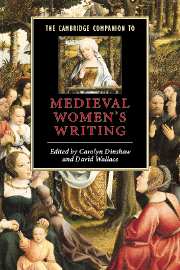4 - Widows
from Part I - Estates of women
Published online by Cambridge University Press: 28 May 2006
Summary
In a late medieval society in which young maidens were the ideal of beauty and desirability, the widow was not the most favoured subject among authors. Chaucer drew three notable portraits of widows - the Wife of Bath, Criseyde, and the poor peasant widow in The Nun's Priest's Tale - in addition to the widow in The Friar's Tale. Other widows appear in The Canterbury Tales but their status is not elaborated. Alisoun, despite outliving five husbands, is not called the Widow of Bath. For the fifteenth century, William Dunbar's poem, 'The Tretis of the Tua Mariit Wemen and the Wedo', provides a picture of a widow sharing some of the Wife of Bath's robust sexual views. The literatures of France and Spain, and of course Italy, also feature lively widow stories. Literary attitudes towards widows cover a wide range: January in The Merchant's Tale says he will marry a maid rather than a widow because widows can take property without producing heirs; in The Prioress's Tale, the mother of the young boy is described as a poor widow raising her son alone; and in Troilus and Criseyde the allure of a young widow's black clothes forms part of the temptation to romance. Historical backgrounds for all these perceptions of widows will form part of this chapter.
Widows were ubiquitous in medieval Europe. Contrary to the popular myth that the most common cause of death for adult women was childbirth and that, as a consequence, men outnumbered women, the majority of women survived their husbands. Some, like the Wife of Bath, outlived several. From fifteenth-century rural wills of adult males from Bedfordshire, we learn that 72 per cent had a surviving wife.
- Type
- Chapter
- Information
- The Cambridge Companion to Medieval Women's Writing , pp. 58 - 69Publisher: Cambridge University PressPrint publication year: 2003



